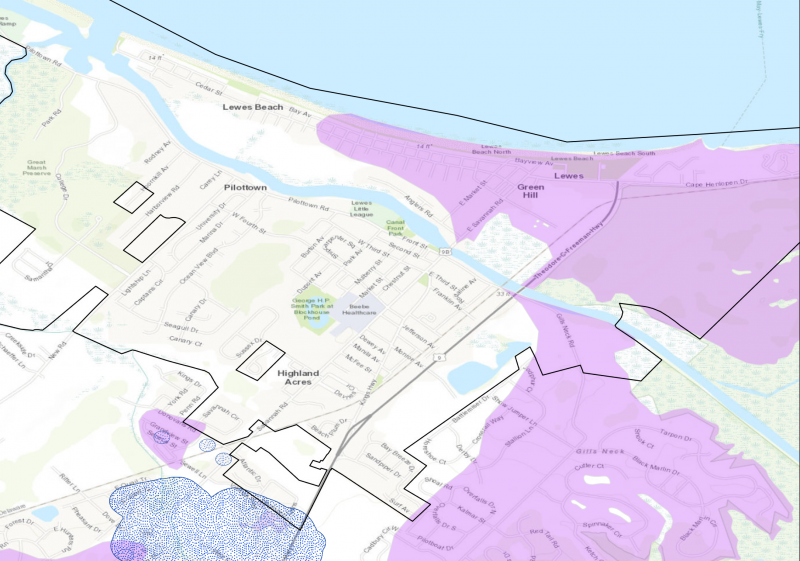Lewes to enforce building standards within protected area
All construction within a certain section of Lewes’ excellent water recharge area must now adhere to stringent city code on maximum impervious surface.
The ordinance had been ignored for many years, resulting in more than 60 homes being built between the Lewes-Rehoboth Canal and the Delaware Bay that exceed the limit of 20 percent impervious surface on a property.
Mayor and city council adopted the ordinance around 2008 to meet requirements of a state statute. The ordinance allows impervious cover to increase to 50 percent if the applicant provides an environmental impact assessment report that shows post-development water recharge will be no less than pre-development recharge.
The excellent recharge area comprises a large section of Lewes Beach, from Cape Henlopen State Park north past Savannah Road and about halfway to Roosevelt Inlet. Building within the defined area is more restrictive to allow for more groundwater to funnel down and replenish the aquifer, from which many Delaware communities draw for drinking water.
At its Feb. 8 meeting, mayor and city council determined that four construction applications submitted prior to Feb. 9 would be allowed to move ahead without meeting code requirements for impervious surface, but any plans submitted after that date must adhere to code standards or wait until city officials revise code, which is expected to happen within the next six months.
A wetlands buffer subcommittee of the Lewes Planning Commission will discuss the issue at its Tuesday, Feb. 16 meeting. That group will review a draft ordinance before sending it to the planning commission for consideration. Planning commission members will then review it before sending it up to the mayor and city council level.
In discussing the issue with representatives at Delaware Department of Natural Resources and Environmental Control, City Manager Ann Marie Townshend said the intent of the state statute is to protect the aquifer and drinking water for all communities, not just Lewes.
Some members of the public have lobbied to have the standards relaxed, because studies have shown water on Lewes Beach does not reach the aquifer.
One of those studies was completed by Steve Cahill of Duffield Associates, who has more than 30 years of experience in groundwater studies related to water resource protection.
“Saltwater intrusion has been established way past the canal since the 1950s, and that’s why your wells were moved uphill toward the high school,” he said at a Feb. 1 public hearing.
He said saltwater is heavier than freshwater, and the water that goes into the ground on Lewes Beach most likely runs off into the bay.
“There’s pretty good evidence that this isn’t contributing to protecting source water or drinking water,” he said. “That’s not to say you don’t want to protect what’s here.”
He said the code requirements are cumbersome and don’t apply, and they should be revised with something that’s more appropriate.
Attorney Veronica Faust, representing resident Rick Quill, also argued that many of the strict code requirements are unnecessary, specifically the environmental impact assessment that can cost an applicant up to $30,000.
“We have not seen … how water that infiltrates the ground on Lewes Beach impacts source water anywhere,” she said at the Feb. 1 public hearing. “We just want to make sure that whatever ordinance is crafted to address this issue is crafted reasonably.”
The wetlands buffer subcommittee will meet virtually at 3 p.m., Tuesday, Feb. 16, to continue discussion about a draft ordinance for the excellent recharge area. A link to the meeting can be found on the agenda at lewes.civicweb.net.
Nick Roth is the news editor. He has been with the Cape Gazette since 2012, previously covering town beats in Milton and Lewes. In addition to serving on the editorial board and handling page layout, Nick is responsible for the weekly Delaware History in Photographs feature and enjoys writing stories about the Cape Region’s history. Prior to the Cape Gazette, Nick worked for the Delmarva Media Group, including the Delaware Wave, Delaware Coast Press and Salisbury Daily Times. He also contributed to The News Journal. Originally from Boyertown, Pa., Nick attended Shippensburg University in central Pennsylvania, graduating in 2007 with a bachelor’s degree in journalism. He’s won several MDDC awards during his career for both writing and photography. In his free time, he enjoys golfing, going to the beach with his family and cheering for Philadelphia sports teams.























































